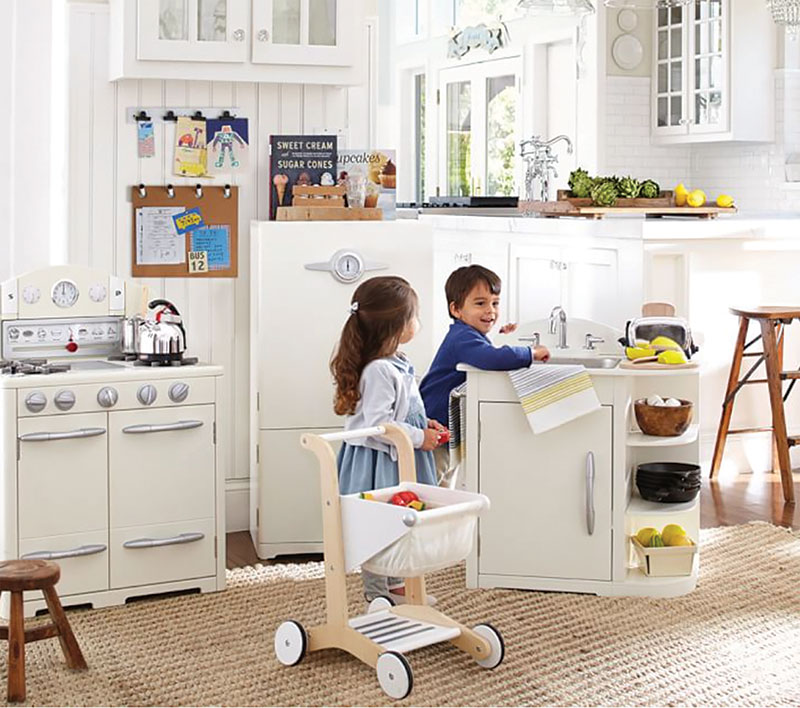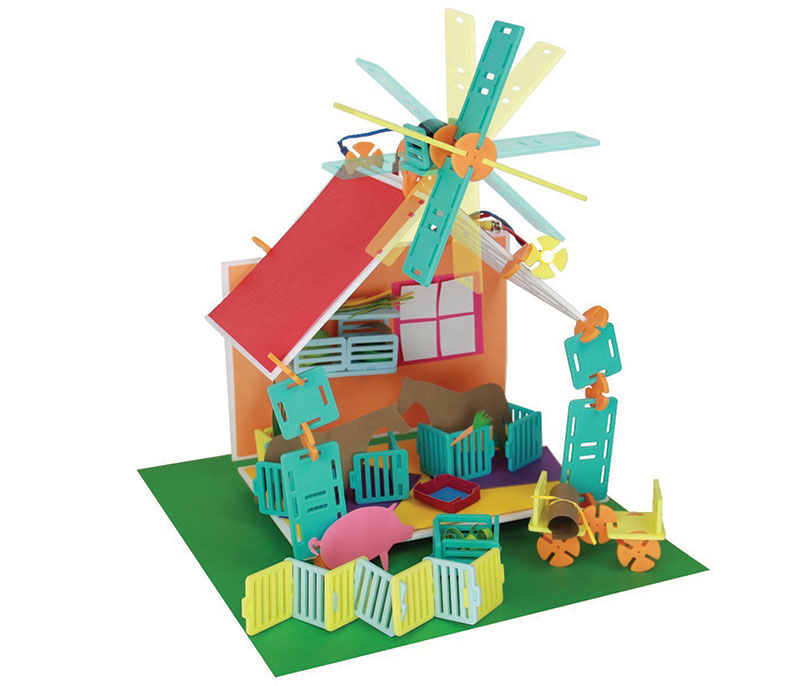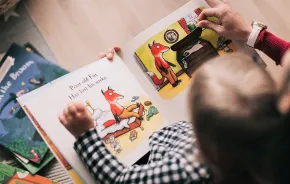

Editor’s note: Science, technology, robotics, engineering, art and math: In our schools and communities, there is more demand than ever for STREAM. Yet only about a third of eighth-graders score “proficient” in math and science. In this ongoing series, sponsored this month by Top Ten Toys, we’ll explore how schools and organizations are approaching STREAM in new, game-changing ways.
When her brother wanted a Hasbro Easy-Bake Oven for Christmas but it only came in traditional “girl” colors of pink or purple, 13-year-old McKenna Pope felt she had to do something. So she went to Change.org, a website that allows people to create petitions, and petitioned the CEO at Hasbro to make the iconic toy more accessible to boys. After more than 45,000 signatures, they took notice. Now, thanks to Pope, Easy-Bake Ovens come in black and silver, too.
Of course, Easy-Bake isn’t the only toy clearly marketed to just one gender. “Pink for girls! Blue for boys!” scream toy aisles everywhere. Often, toy packaging emphasizes beauty and appearance for girls, heroics and physical prowess for boys.
Recently, some stores have sought to change this. Chains like Target have been applauded for bucking the norm and not “genderizing” their toy departments. But while this may seem like a breakthrough — and remains something to celebrate — it’s not really new. Toys placement has always been a mixed bag.
Toys through time
In 2013, sociologist Elizabeth Sweet, Ph.D., reviewed toy advertisements in the Sears-Roebuck catalog throughout the 20th century. She found that from the 1920s through the 1960s, genderizing toys followed cultural distinctions. Girls’ toys mirrored how society saw women as domestic and nurturing while toys for boys emphasized preparation for working in an industrial economy.
That started changing in the 1970s as wider societal events like more women in the workplace influenced cultural norms. In response, toys started to appear more gender-neutral.
“In the wake of those demographic shifts and at the height of feminism’s second wave, playing upon gender stereotypes to sell toys had become a risky strategy,” explains Sweet in a 2014 Atlantic Monthly article.
But by the 1980s, that neutrality shifted once again with changing views regarding feminism and books such as John Gray’s Men Are From Mars, Women Are From Venus, which argued women have “some innate preference” toward certain roles. This wasn’t a new narrative, says Sweet, just a rebranding of long-held stereotypes.
“The reformulated story does not fundamentally challenge gender stereotypes; it merely repackages them to make them more palatable in a ‘post-feminist’ era,” Sweet writes of attitudes of the time. “Girls can be anything — as long as it’s passive and beauty-focused.”
By the 1990s, these distinctions only grew wider, a trend that has continued into the 2000s. These days, as Sweet wrote in a 2012 article for The New York Times, “finding a toy that is not marketed either explicitly or subtly (through use of color, for example) by gender has become increasingly difficult.”

Nature vs. nurture
But why segregate toys by gender in the first place? Because, Sweet says, companies found segmenting the market sells more toys. It also plays upon what many parents “feel” about their sons and daughters: They innately like different toys. Girls tend to reach for nurturing toys, and boys like “rough and tumble” toys, right? Well, maybe not.
Gender distinctions occur throughout a person’s life, says Erica Weisgram, Ph.D., associate professor of psychology at the University of Wisconsin–Stevens Point. Humans create gender stereotypes because sorting and labeling things into neat categories helps hectic lives go more smoothly, even if the labels are biased.
From infancy, children are natural categorizers, says Weisgram. “They take in information from the environment and try to put it into categories to simplify their thinking about the world,” she says. Part of that information is society’s emphasis on gender. “Children begin to categorize themselves and others according to gender,” she explains. “[They begin] seeking out information about the things, such as toys and clothing, [that are] associated with their own group.” In other words, your daughter may not naturally like pink; she may like pink because she thinks that’s what girls are supposed to like.
Kids are basically the same until they are exposed to society’s stereotypes, adds Christia Spears Brown, Ph.D., the author of Parenting Beyond Pink and Blue: How to Raise Your Kids Free of Gender Stereotypes. We’ve become really obsessed with gender and, she says, “the entrenchment makes it hard to change.”
Adults, she says, “latch onto gender and use it with kids.” “We color code everything so kids think that it must be important so they start to look for these differences, believing that it is important because everyone talks about it,” Spears Brown says. Kids don’t start out as different, she adds, but get so over time.
Only recently have scientists started looking to the human brain for the origins of such actions, and some say biology may also influence children’s personal play preferences.
“Much of this is set before birth,” says Dr. David C. Geary of the University of Missouri Department of Psychological Sciences in an email interview. “These play preferences are influenced by prenatal and early postnatal exposure to sex hormones so most kids play with what’s available to them.”
As evidence, Geary points to the play of children raised in homes where parents avoid gender stereotypes. It doesn’t differ much from that of children raised in more traditional homes. As such, “I doubt that gender-neutral toys will strongly influence children’s play preferences,” he says.
Clearly divisions exist in the research, but that’s not of much help to parents in the thick of raising their children. “Parents are frustrated because, in reality, our kids are really just individuals with their own unique strengths, characteristics and things that they enjoy and don’t enjoy,” Spears Brown says. “Parents are forced to figure out what their kids need while surrounded by all these stereotypes in pink and blue. You are almost forced to make a political statement when you are in the toy aisle when all you want to do is buy your kid a toy.”

What kids think
In her 2014 study “Pink Gives Girls Permission,” Weisgram of the University of Wisconsin–Stevens Point found girls don’t show a preference for pink until age 2½. Boys start avoiding pink at about the same age in what Weisgram calls the “hot potato effect.”
They’re reluctant to cross over and play with girls’ toys regardless of the color. If it was a girl toy and the boy knew or thought that it was a girl toy, he wouldn’t play with it, says Weisgram. The same was true for girls; they’d avoid an attractive toy if they believed it was for boys. One way kids could tell: the colors associated with the toy.
We need to introduce girls to STEM from an early age in a way that makes them feel like they belong to STEM. Otherwise, we’ll never know which girls might have discovered a passion for STEM.
“Pink is a signal that a toy is ‘for girls’ and ‘not for boys,’” Weisgram says. “[It’s] an implicit label that is put on toys.”
That’s what makes those pink, purples and pastels — traditional “girl” colors — you’re seeing on STEM (science, technology, engineering and math)-related toys like Legos — traditional “boy” toys — such a big deal.
It’s also leading to toys that use gender stereotypes to introduce a new way of play. Take toy company Roominate; the company sells building sets that encourage kids to create their own toys or, as Roominate co-inventor Alice Brooks explains, Roominate combines “the more traditionally ‘girl’ play patterns of storytelling, crafting, doll play and design with engineering, circuits, and construction.” The toy maker seeks to reflect that in its color palette of teal, purple, pink and other pastels.
As with Roominate products, toys created by KiwiCrate focus on science, engineering, technology, arts and math (STEAM) and feature more gender-neutral colors including green, orange and gold. With blueprints and building materials, KiwiCrate sets are project-oriented; among other options, you can build a hydraulic claw or a trebuchet.
The toys are “very intentionally designed for tinkering,” says CEO Sandra Oh Lin, who founded KiwiCrate because she wanted to give her sons and daughter the same opportunities “to explore, discover and experiment without barriers or limits.”
But does it work? Is it really possible to take the gender out of toys and by doing so, can we get more girls interested in science, math, technology, engineering and robotics? It’s a question Allison Master, Ph.D., often finds herself asking.
A research scientist at the Institute for Learning and Brain Sciences at the University of Washington, Master wonders if girls’ documented hesitation around stereotypical boy activities like math and science is actually “their choice, or is it because they’ve been given so many messages that STEM is not for them?”
It could take decades to get a clear answer, Master says. In the meantime, “We need to introduce girls to STEM from an early age in a way that makes them feel like they belong to STEM. Otherwise, we’ll never know which girls might have discovered a passion for STEM.”
Early signs are promising, however. In one group of 6-year-olds Master worked with, boys reported being more interested and confident in STEM than girls, but when given the same activity — playing with an animal robot programmable by smartphone — the girls became just as confident and interested as the boys. In other words, the toy helped girls get more interested in STEM.
What you can do
Parents and teachers should encourage children to ask questions about the messages they receive from society at large. Adults can also lead by example. In the classroom, for example, teachers can create gender-neutral environments by using diverse materials, toys and books, Weisgram says, and they can celebrate all scientists, regardless of gender.
At home, parents can talk to their children early, as young as age 2, about stereotypes, including those related to gender, says Spears Brown. Perhaps point out the differences while shopping together. Such actions draw attention to stereotypes and help kids understand them.
“Even though you can’t censor everything, if your kids are young enough to learn the stereotype, they are old enough to recognize that it is a stereotype,” Spears Brown says. “You want your voice in their ear rather than society’s voice in their ear.”











